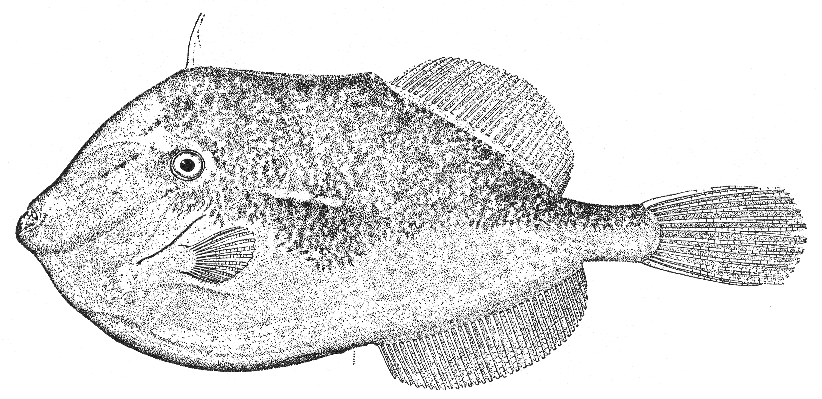Orange filefish Alutera schoepfii (Walbaum) 1792 [1]
FILEFISH; TURBOT; HOGFISH; SUNFISH; UNICORNFISH
[Jordan and Evermann, 1896-1900, p. 1718.]

Figure 278.—Orange filefish (Alutera schoepfii), Key West, Florida. From Jordan and Evermann. Drawing by W. S. Haines.
Description—
This fish resembles its relatives of the genus Monacanthus in most respects (p. 521), but while it is equally flattened sidewise, it is relatively shallower, being not over half as deep as long. The pelvic bone is as prolonged as it is in the other filefishes, but it does not project externally, nor is there a ventral dewlap, which is the readiest field mark by which to distinguish Alutera from Monacanthus. The eyes, too, are set lower down on the sides of the head, and the gill openings are relatively longer and more oblique. The dorsal spine is relatively shorter than in Monacanthus, and the lower jaw projects considerably beyond the upper. The soft dorsal fin (34-38 rays) originates behind the middle of the trunk and is rounded in outline, and the anal fin (36-41 rays) corresponds to the soft dorsal fin in size, shape, and position. The short rounded pectorals are situated opposite the lower half of the oblique gill openings and the tail fin is relatively narrower than in the other filefishes or triggerfishes; its longest rays are more than 1/2 as long as the body in small specimens, but only one-fourth to one-fifth as long as the body in half-grown fish and larger.
Color—
Described as varying from uniform olive gray to rich orange yellow or to milky white above, mottled with darker hues of the same tints; bluish white beneath. The caudal fin usually is yellowish on adults but sometimes it is dusky, edged with white.
Size—
Maximum length about 2 feet.
General range—
Atlantic and Gulf of Mexico coasts of the United States; not uncommon in summer as far north as Cape Cod; reported to Portland, Maine, and perhaps to Halifax, Nova Scotia.[2]
[page 525]Occurrence in the Gulf of Maine—
Although the orange filefish has been described as "rather common" at Woods Hole during the summer,[3] only 3 specimens have been reported within the limits of the Gulf of Maine: 1 from Portland, Maine, and 2 from Salem, Mass., all of them many years ago.[4] Evidently it reaches the Gulf of Maine only at long intervals, as a waif from the south.
[1] Jordan, Evermann, and Clark (Rept. U. S. Comm. Fish. (1928), Pt. 2, 1930, p. 495) place the species in the genus Ceratacanthus Gill 1801.
[2] A specimen, found in Halifax Harbor, August 25, 1938 appears to have belonged to this species, but it was not in good enough condition for positive identification (McKenzie, Proc. Nova Scotian Inst. Sci., vol. 20, 1939, p. 19)
[3] Sumner, Osburn, and Cole, Bull. U. S. Bur. Fish., vol. 31, Pt. 2, 1913, p. 762.
[4] There is no way to verify the identifications at this late date.